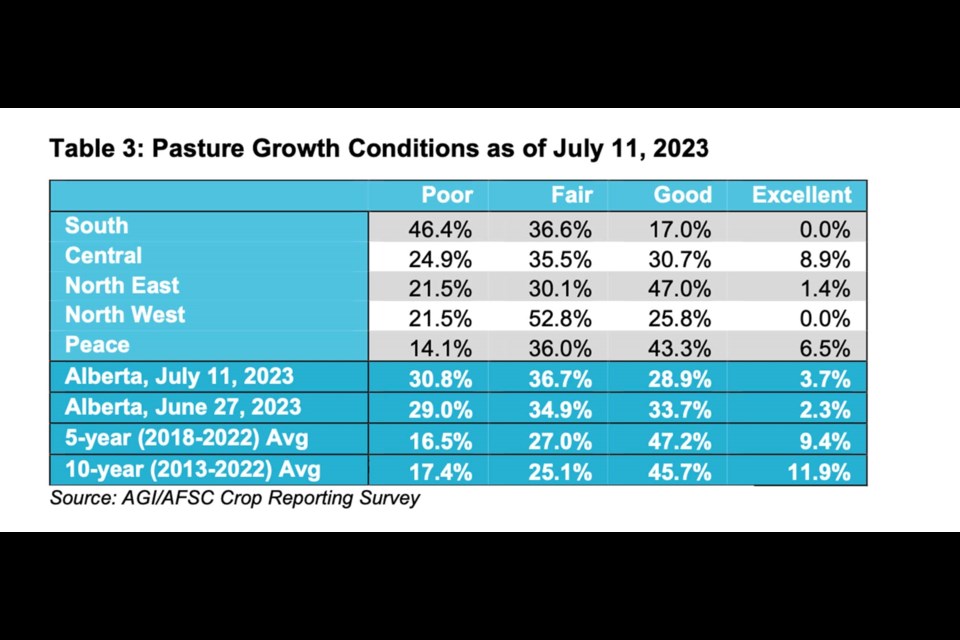Rains over the last two weeks helped stabilize crop conditions in the province but crops are still rated well below the five- and 10-year averages, according to a government report released last week.
On July 14, the province released the Alberta Crop Report stating 45 per cent of crops are in good to excellent condition as of July 11, 2023. This is a drop from the five-year average of 66.1 per cent and the 10-year average of 67.6 per cent.
The North East and Peace region had the highest-rated growth conditions at 59 and 58 per cent of crops being rated good to excellent respectively, the report said.
The South had the lowest-rated crops, with only 35 per cent at good to excellent.
“The rest of the regions were 13 (North East) to 39 (Central) per cent below the five-year average of crops rated in good to excellent condition,” said the report.
Flowering crops include spring cereals and 83 per cent of the major broadleaf crops.
“Podding is most present in the South at 19 per cent, while the rest of the province ranges from seven-10 per cent,” the report noted.
Head emergence in crops across the province are above of the five-year average and flowering is the average at 75 per cent.
The best-rated crops are spring wheat, oats, lentils, potatoes and chickpeas, while the lowest-rated crops include durum, mustard, and flax.
Soil moisture conditions have been reported as stable since the last report and surface soil moisture, as of July 11, is rated “21 per cent poor, 33 per cent fair, 31 per cent good, 14 per cent excellent and one per cent excessive.”
The sub-surface soil moisture has stayed around 37 per cent.
“Soil moisture reserves are experiencing once-in-three-to-five-year lows to once-in-50-year lows in select areas around the South, North East, and Peace Region,” said the report.
Tame hay conditions have moderately increased by four per cent from 31 per cent rated good to excellent the second week of June, to 35 per cent rated good to excellent, 27 per cent rated poor, 38 per cent rated fair, and 29 per cent rated good and six per cent rated excellent. The Peace region is rated the highest.
The first cut of dryland hay had an average yield of 0.9 tons per acre, while the first cut for irrigated had an average yield of 2.0 tons per acre.
“Currently, 59 per cent of dryland first cut is complete, well ahead of the five-year average (38 per cent),” the report said.
Pasture conditions have slightly decreased since the third week of June, and the report said some producers are putting annual crops into grazing rotation because of lack of feed.
“Only 33 per cent of the pastures in Alberta are rated as good to excellent. Overall, 31 per cent are rated as poor, 37 per cent fair, 29 per cent good and four per cent excellent,” the report said.
In the South Region, which includes Strathmore, Lethbridge, Medicine Hat and Foremost, crop conditions have decreased six per cent since the last report. Crop quality has also decreased from heat and lack of rain, surface and subsurface soil moisture have also decreased, and pasture shortages are causing producers to take annual crops for feed.
It is estimated there is pod loss in oilseeds and pulses, and grasshopper are “over threshold in 17 per cent of acres,” said the report.
The Central Region, which includes Rimbey, Airdrie, Coronation, and Oyen, has seen a five per cent increase in crop conditions rated good to excellent, and rains are helping fill in patchy crops, but crops are still stunted. Producers are spraying fungus because of the moisture.
Despite the rain, soil moisture levels have decreased slightly.
The report said hay crops have matured faster than normal, and the “first cut dryland hay yield has averaged (irrigated in brackets) 0.8 (1.5) tons/acre.”
The North East region which includes Smoky Lake, Vermillion, Camrose, and Provost has had stable crop conditions since the last report. Soil moisture conditions have increased slightly.
The first cut of dryland hay is reported as averaging one ton per acre, but “recent rains give more confidence to a second cut.”
The North West Region, which includes Barrhead, Edmonton, Leduc, Drayton Valley, and Athabasca reported flowering of cereals that “seem to be progressing well but are short and small, and canola staging is extremely variable.”
Soil moisture has increased because of scattered showers.
The report said producers are spraying to mitigate grasshopper damage and there have been reports of hail damage in the region.
Currently, pasture is rated at (tame hay conditions in brackets) 22 (19) per cent poor, 53 (48) per cent fair, 26 (32) per cent good, and zero (one) per cent excellent. First cut dryland hay is averaging yields of 0.7 tons per acre,” the report said.
The Peace Region, which includes Fairview, Falher, Grande Prairie, and Valleyview, has seen a decrease in crop conditions from hot conditions and only occasional rains.
However, rains have” helped” subsurface soil moisture.
“The good to excellent rating increased by three per cent but surface soil moisture still decreased by three per cent,” the report said.
The Peace Region has the highest-rated dryland hay yields, and they are averaging 1.2 tons per acre.
The crop report is released biweekly during summer months. The full report can be found here https://open.alberta.ca/dataset/92dc0d33-edc7-47ec-be8d-a334ea145ded/resource/3d40ce60-5efb-4e46-8cdb-17e7182ac2f7/download/agi-itrb-alberta-crop-report-2023-07-11.pdf


.jpg;w=120;h=80;mode=crop)
